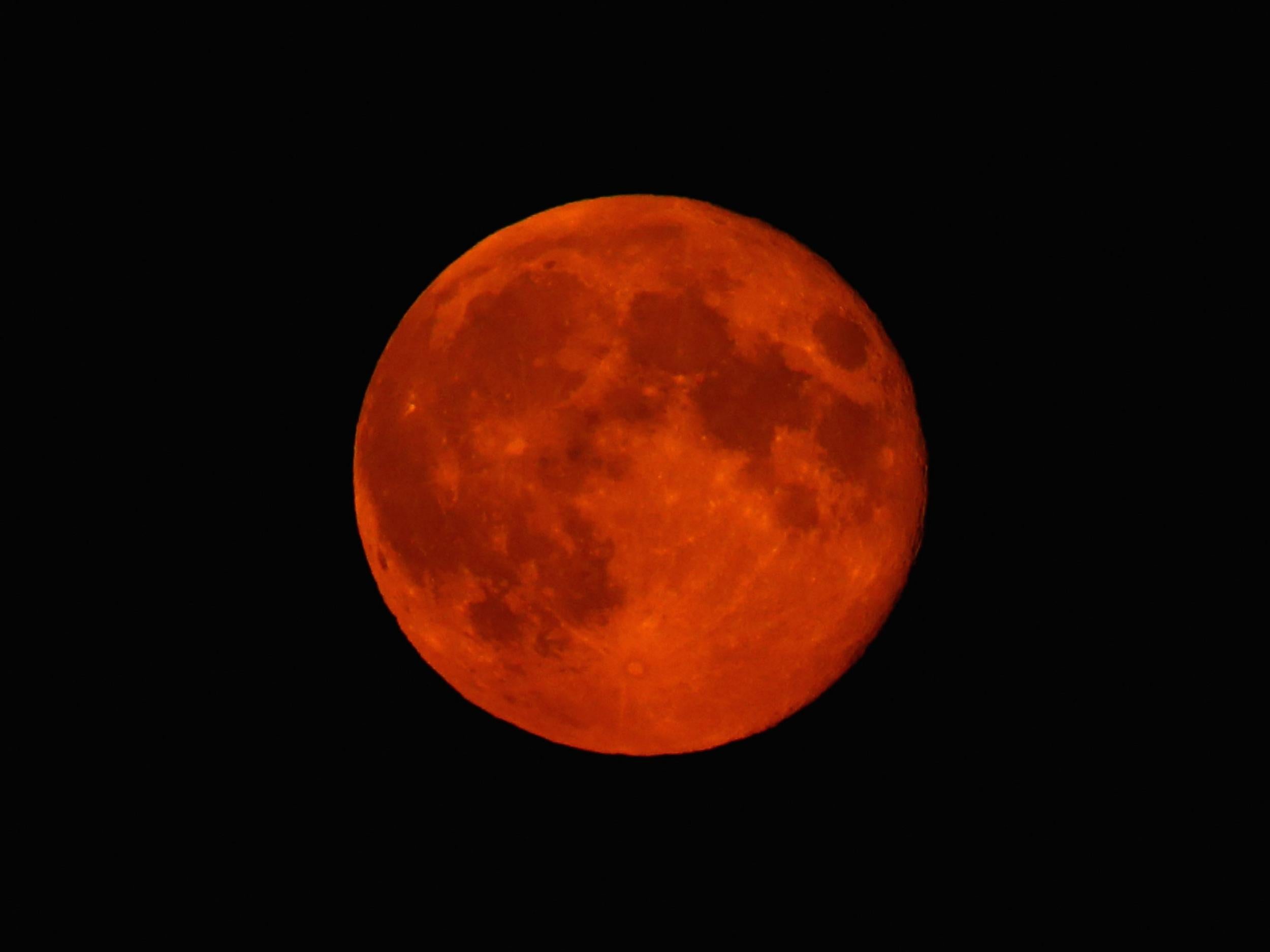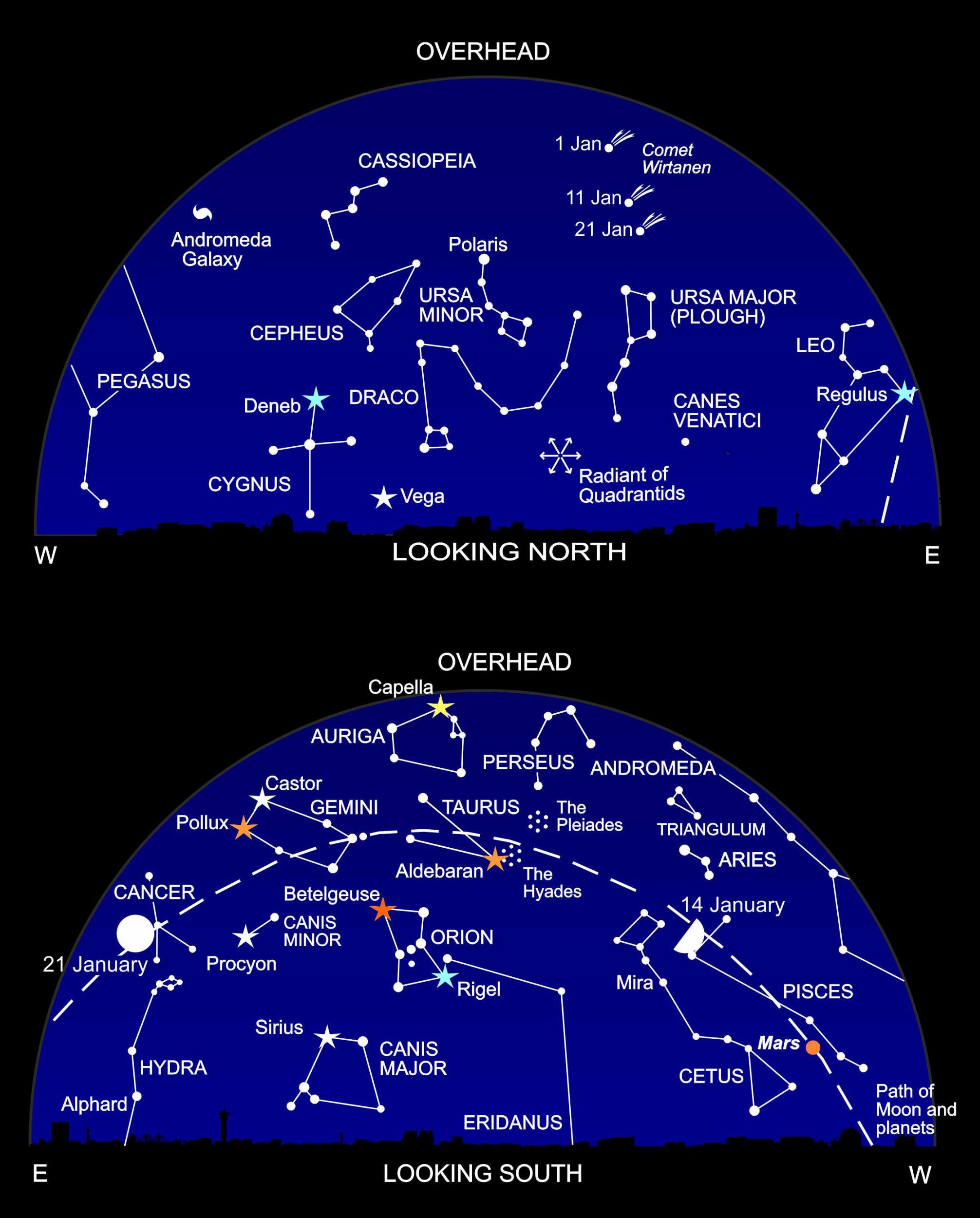Stargazing January: Copper-coloured supermoon looms during total eclipse
This month the full moon will not only be closer to Earth than usual, appearing unusually big and bright in the sky, it will also take on a reddish hue as it enters the Earth’s shadow

Your support helps us to tell the story
From reproductive rights to climate change to Big Tech, The Independent is on the ground when the story is developing. Whether it's investigating the financials of Elon Musk's pro-Trump PAC or producing our latest documentary, 'The A Word', which shines a light on the American women fighting for reproductive rights, we know how important it is to parse out the facts from the messaging.
At such a critical moment in US history, we need reporters on the ground. Your donation allows us to keep sending journalists to speak to both sides of the story.
The Independent is trusted by Americans across the entire political spectrum. And unlike many other quality news outlets, we choose not to lock Americans out of our reporting and analysis with paywalls. We believe quality journalism should be available to everyone, paid for by those who can afford it.
Your support makes all the difference.The new year brings in a celestial fireworks display. Weather permitting (a big IF), you’ll see an outburst of shooting stars over the night of 3/4 January – the best meteor display of 2019.
These are the Quadrantids – named after the defunct constellation of Quadrans Muralis (the Mural Quadrant), which lies near the “tail” of the Great Bear (Ursa Major) in the north of the sky.
The Quadrantids are just one of over half a dozen meteor showers that hit our planet every year. The most famous are the Perseids (August), and the Geminids (December). They’re named from the constellation from which they appear to emanate.
Meteors are tiny particles of cosmic dust which boil off comets as they traipse around the sun. When we hit a cloud of “celestial soot”, we get a meteor shower. And although they come into us in parallel lines, think of driving along a motorway. The distant lanes seem to converge towards the horizon, due to perspective. And so it is with meteor showers. The Perseids appear to fly outwards from the constellation of Perseus. The Geminids diverge from Gemini.
Alas: neither of these showers will tick the box this year. The full moon will be in the way – and all you’ll see will be the brightest meteors.
But no worries. You can see a shooting star at any time – as I (Heather) did. I must have been aged 7-8, and I was watching planes at night stacking over Heathrow airport. My dad was a pilot, and I wanted to follow him – I loved planes.
Then I saw it. A shooting star – but it was GREEN! I rushed into the living room and told my parents – only to be told: “Well, that’s nice, dear. But there’s no such thing as a green shooting star.”
On the front of a national newspaper the following day, there was a tiny paragraph: “Green shooting star seen over west London.” I told my parents immediately that I’d given up the idea of becoming a pilot. I was going to be an astronomer, instead. And the rest is history…

A lot of people ask me why the meteor was green. Meteors hurtle into the atmosphere at around 100km up, and burn up at 60km. Travelling at 200,000km/hr, they have seriously nasty effects on our planet’s air layers, and create a characteristic streak as they burn up. The consensus is that my meteor energised the oxygen atoms in the atmosphere, causing them to glow green.
But – back to the Quadrantids. What to expect? With the moon out of the way and no light pollution, you’ll see maybe 120 meteors per hour in a dark location, with peak activity between 2 and 3am. The meteors come from the not-so-inspirationally-named 2003EH1, a piece of space rock that’s probably an aged and defunct comet that passes close to Earth.
However, you can never tell with meteor showers. In November 1833, the Leonids ditched 240,000 shooting stars over the United States. People are reported to have been terrified, waking up in the night and believing that their houses were on fire.
What’s up?
The Christmas comet is still with us. Though it’s now fading, early January is still a great time to catch Comet Wirtanen. The faint fuzzy beast is high in the northern sky, near the familiar figure of the Plough (see the starchart), and we are seeing it in dark skies as the moon doesn’t rise till nearly dawn. Make the most of the comet while you can: there isn’t another naked-eye comet forecast for several years!
As well as the only comet of the year and the best shooting star display, January’s cornucopia of celestial sights includes the best eclipse of the year – a total eclipse of the supermoon on the night of 20/21 January.
OK, a word first about the “supermoon”. That’s a full moon that happens to be nearer to the Earth than usual, so it looks unusually big and bright in the sky – though don’t expect too much, as it’s only 15 per cent brighter than the average full moon.
At 3.34am on 21 January, this bright orb begins to enter the Earth’s shadow. As the sun’s light is cut off, darkness spreads across the face of the moon until – at 4.41am – it’s totally obscured. Even during total eclipse, though, the moon doesn’t completely disappear. The Earth’s atmosphere refracts some sunlight round into our planet’s shadow, reddening the light in the process – just as a sunset appears red. During the period of totality, from 4.41 to 5.43am, we expect the moon to shine a dull copper colour.
The evening skies are ablaze with the brilliant constellations of winter: the giant hunter Orion and his entourage, including the brightest star in the sky, dazzling Sirius, the Dog Star. To the upper right you’ll find orange Aldebaran in Taurus (the Bull), and the lovely little star cluster of the Pleiades, more poetically known as the Seven Sisters.
Way over the right again, Mars is still above the southwestern horizon until it sets about 11.30pm: the red planet is gradually fading as the Earth pulls away from it.
There’s much more planetary action in the morning sky, over in the southeast. Glorious Venus dominates the view, shining far more brilliantly than any star. During the course of January, giant planet Jupiter rises up from the horizon and heads towards the Morning Star, passing it on the morning of 22 January, when we’re treated to the stunning sight of the two brightest planets up close and personal.
And there’s another beautiful sight on the last two mornings of the month, as the slender crescent moon joins Venus and Jupiter.
Diary
3 January, 5.20am: Earth at perihelion (closest to the sun)
3/4 January: maximum of Quadrantid meteor shower
6 January, 1.28am: new moon; partial solar eclipse (visible from China, Japan and the northwest Pacific); Venus at greatest elongation west
12 January: moon near Mars
14 January, 6.46am: moon at first quarter
17 January: moon near Aldebaran and the Hyades
21 January, 5.16am: full moon; supermoon; total lunar eclipse
22 January: Venus near Jupiter (am); moon near Regulus
27 January, 9.11pm: moon at last quarter
30 January: moon near Venus and Jupiter (am)
31 January: moon between Venus and Jupiter (am)
Fully illustrated, ‘The Universe Explained’ by Heather Couper and Nigel Henbest is packed with 185 of the questions that people ask about the cosmos, from the existence of alien life to what happened before the big bang
And Heather and Nigel’s ‘Philip’s 2019 Stargazing’ reveals everything that’s going on in the sky this year
Join our commenting forum
Join thought-provoking conversations, follow other Independent readers and see their replies
Comments